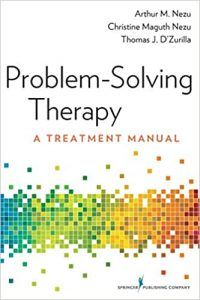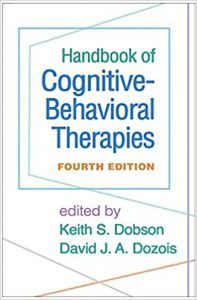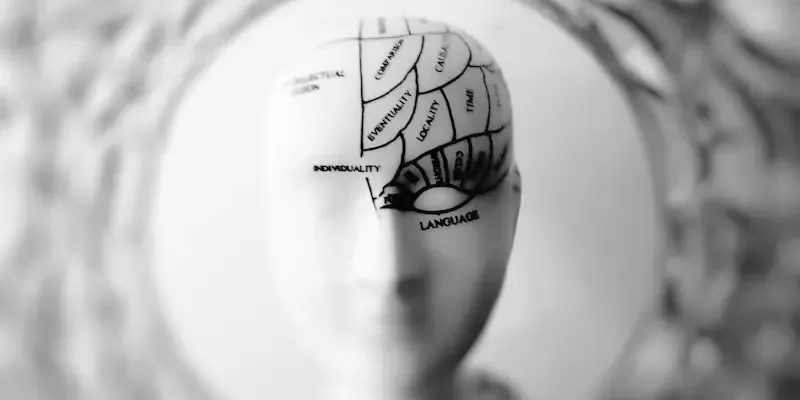10 Best Problem-Solving Therapy Worksheets & Activities
 Humans are excellent problem-solvers, born with an innate ability to find solutions to day-to-day challenges.
Humans are excellent problem-solvers, born with an innate ability to find solutions to day-to-day challenges.
Cognitive science tells us that we regularly face not only well-defined problems but, importantly, many that are ill defined (Eysenck & Keane, 2015).
Sometimes, we find ourselves unable to overcome our daily problems or the inevitable (though hopefully infrequent) life traumas we face.
Problem-Solving Therapy aims to reduce the incidence and impact of mental health disorders and improve wellbeing by helping clients face life’s difficulties (Dobson, 2011).
This article introduces Problem-Solving Therapy and offers techniques, activities, and worksheets that mental health professionals can use with clients.
Before you continue, we thought you might like to download our three Positive Psychology Exercises for free. These science-based exercises explore fundamental aspects of positive psychology, including strengths, values, and self-compassion, and will give you the tools to enhance the wellbeing of your clients, students, or employees.
This Article Contains:
What Is Problem-Solving Therapy?
Problem-Solving Therapy assumes that mental disorders arise in response to ineffective or maladaptive coping. By adopting a more realistic and optimistic view of coping, individuals can understand the role of emotions and develop actions to reduce distress and maintain mental wellbeing (Nezu & Nezu, 2009).
“Problem-solving therapy (PST) is a psychosocial intervention, generally considered to be under a cognitive-behavioral umbrella” (Nezu, Nezu, & D’Zurilla, 2013, p. ix). It aims to encourage the client to cope better with day-to-day problems and traumatic events and reduce their impact on mental and physical wellbeing.
Clinical research, counseling, and health psychology have shown PST to be highly effective in clients of all ages, ranging from children to the elderly, across multiple clinical settings, including schizophrenia, stress, and anxiety disorders (Dobson, 2011).
Can it help with depression?
PST appears particularly helpful in treating clients with depression. A recent analysis of 30 studies found that PST was an effective treatment with a similar degree of success as other successful therapies targeting depression (Cuijpers, Wit, Kleiboer, Karyotaki, & Ebert, 2020).
Other studies confirm the value of PST and its effectiveness at treating depression in multiple age groups and its capacity to combine with other therapies, including drug treatments (Dobson, 2011).
The major concepts
Effective coping varies depending on the situation, and treatment typically focuses on improving the environment and reducing emotional distress (Dobson, 2011).
PST is based on two overlapping models:
Social problem-solving model
This model focuses on solving the problem “as it occurs in the natural social environment,” combined with a general coping strategy and a method of self-control (Dobson, 2011, p. 198).
The model includes three central concepts:
- Social problem-solving
- The problem
- The solution
The model is a “self-directed cognitive-behavioral process by which an individual, couple, or group attempts to identify or discover effective solutions for specific problems encountered in everyday living” (Dobson, 2011, p. 199).
Relational problem-solving model
The theory of PST is underpinned by a relational problem-solving model, whereby stress is viewed in terms of the relationships between three factors:
- Stressful life events
- Emotional distress and wellbeing
- Problem-solving coping
Therefore, when a significant adverse life event occurs, it may require “sweeping readjustments in a person’s life” (Dobson, 2011, p. 202).
14 Steps for Problem-Solving Therapy

- Enhance positive problem orientation
- Decrease negative orientation
- Foster ability to apply rational problem-solving skills
- Reduce the tendency to avoid problem-solving
- Minimize the tendency to be careless and impulsive
D’Zurilla’s and Nezu’s model includes (modified from Dobson, 2011):
- Initial structuring
Establish a positive therapeutic relationship that encourages optimism and explains the PST approach. - Assessment
Formally and informally assess areas of stress in the client’s life and their problem-solving strengths and weaknesses. - Obstacles to effective problem-solving
Explore typically human challenges to problem-solving, such as multitasking and the negative impact of stress. Introduce tools that can help, such as making lists, visualization, and breaking complex problems down. - Problem orientation – fostering self-efficacy
Introduce the importance of a positive problem orientation, adopting tools, such as visualization, to promote self-efficacy. - Problem orientation – recognizing problems
Help clients recognize issues as they occur and use problem checklists to ‘normalize’ the experience. - Problem orientation – seeing problems as challenges
Encourage clients to break free of harmful and restricted ways of thinking while learning how to argue from another point of view. - Problem orientation – use and control emotions
Help clients understand the role of emotions in problem-solving, including using feelings to inform the process and managing disruptive emotions (such as cognitive reframing and relaxation exercises). - Problem orientation – stop and think
Teach clients how to reduce impulsive and avoidance tendencies (visualizing a stop sign or traffic light). - Problem definition and formulation
Encourage an understanding of the nature of problems and set realistic goals and objectives. - Generation of alternatives
Work with clients to help them recognize the wide range of potential solutions to each problem (for example, brainstorming). - Decision-making
Encourage better decision-making through an improved understanding of the consequences of decisions and the value and likelihood of different outcomes. - Solution implementation and verification
Foster the client’s ability to carry out a solution plan, monitor its outcome, evaluate its effectiveness, and use self-reinforcement to increase the chance of success. - Guided practice
Encourage the application of problem-solving skills across multiple domains and future stressful problems. - Rapid problem-solving
Teach clients how to apply problem-solving questions and guidelines quickly in any given situation.
Success in PST depends on the effectiveness of its implementation; using the right approach is crucial (Dobson, 2011).
Problem-solving therapy – Baycrest
3 Best Interventions and Techniques
The following interventions and techniques are helpful when implementing more effective problem-solving approaches in client’s lives.
First, it is essential to consider if PST is the best approach for the client, based on the problems they present.
Is PPT appropriate?
It is vital to consider whether PST is appropriate for the client’s situation. Therapists new to the approach may require additional guidance (Nezu et al., 2013).
Therapists should consider the following questions before beginning PST with a client (modified from Nezu et al., 2013):
- Has PST proven effective in the past for the problem? For example, research has shown success with depression, generalized anxiety, back pain, Alzheimer’s disease, cancer, and supporting caregivers (Nezu et al., 2013).
- Is PST acceptable to the client?
- Is the individual experiencing a significant mental or physical health problem?
All affirmative answers suggest that PST would be a helpful technique to apply in this instance.
Five problem-solving steps
The following five steps are valuable when working with clients to help them cope with and manage their environment (modified from Dobson, 2011).
Ask the client to consider the following points (forming the acronym ADAPT) when confronted by a problem:
- Attitude
Aim to adopt a positive, optimistic attitude to the problem and problem-solving process. - Define
Obtain all required facts and details of potential obstacles to define the problem. - Alternatives
Identify various alternative solutions and actions to overcome the obstacle and achieve the problem-solving goal. - Predict
Predict each alternative’s positive and negative outcomes and choose the one most likely to achieve the goal and maximize the benefits. - Try out
Once selected, try out the solution and monitor its effectiveness while engaging in self-reinforcement.
If the client is not satisfied with their solution, they can return to step ‘A’ and find a more appropriate solution.
Positive self-statements
When dealing with clients facing negative self-beliefs, it can be helpful for them to use positive self-statements.
Use the following (or add new) self-statements to replace harmful, negative thinking (modified from Dobson, 2011):
- I can solve this problem; I’ve tackled similar ones before.
- I can cope with this.
- I just need to take a breath and relax.
- Once I start, it will be easier.
- It’s okay to look out for myself.
- I can get help if needed.
- Other people feel the same way I do.
- I’ll take one piece of the problem at a time.
- I can keep my fears in check.
- I don’t need to please everyone.
7 Activities and Worksheets for Your Session

5 Worksheets and workbooks
Problem-Solving Self-Monitoring Form
Answering the questions in the Problem-Solving Self-Monitoring Form provides the therapist with necessary information regarding the client’s overall and specific problem-solving approaches and reactions (Dobson, 2011).
Ask the client to complete the following:
- Describe the problem you are facing.
- What is your goal?
- What have you tried so far to solve the problem?
- What was the outcome?
Reactions to Stress
It can be helpful for the client to recognize their own experiences of stress. Do they react angrily, withdraw, or give up (Dobson, 2011)?
The Reactions to Stress worksheet can be given to the client as homework to capture stressful events and their reactions. By recording how they felt, behaved, and thought, they can recognize repeating patterns.
What Are Your Unique Triggers?
Helping clients capture triggers for their stressful reactions can encourage emotional regulation.
When clients can identify triggers that may lead to a negative response, they can stop the experience or slow down their emotional reaction (Dobson, 2011).
The What Are Your Unique Triggers? worksheet helps the client identify their triggers (e.g., conflict, relationships, physical environment, etc.).
Problem-Solving worksheet
Imagining an existing or potential problem and working through how to resolve it can be a powerful exercise for the client.
Use the Problem-Solving worksheet to state a problem and goal and consider the obstacles in the way. Then explore options for achieving the goal, along with their pros and cons, to assess the best action plan.
Getting the Facts
Clients can become better equipped to tackle problems and choose the right course of action by recognizing facts versus assumptions and gathering all the necessary information (Dobson, 2011).
Use the Getting the Facts worksheet to answer the following questions clearly and unambiguously:
- Who is involved?
- What did or did not happen, and how did it bother you?
- Where did it happen?
- When did it happen?
- Why did it happen?
- How did you respond?
2 Helpful Group Activities
While therapists can use the worksheets above in group situations, the following two interventions work particularly well with more than one person.
Generating Alternative Solutions and Better Decision-Making
A group setting can provide an ideal opportunity to share a problem and identify potential solutions arising from multiple perspectives.
Use the Generating Alternative Solutions and Better Decision-Making worksheet and ask the client to explain the situation or problem to the group and the obstacles in the way.
Once the approaches are captured and reviewed, the individual can share their decision-making process with the group if they want further feedback.
Visualization
Visualization can be performed with individuals or in a group setting to help clients solve problems in multiple ways, including (Dobson, 2011):
- Clarifying the problem by looking at it from multiple perspectives
- Rehearsing a solution in the mind to improve and get more practice
- Visualizing a ‘safe place’ for relaxation, slowing down, and stress management
Guided imagery is particularly valuable for encouraging the group to take a ‘mental vacation’ and let go of stress.
Ask the group to begin with slow, deep breathing that fills the entire diaphragm. Then ask them to visualize a favorite scene (real or imagined) that makes them feel relaxed, perhaps beside a gently flowing river, a summer meadow, or at the beach.
The more the senses are engaged, the more real the experience. Ask the group to think about what they can hear, see, touch, smell, and even taste.
Encourage them to experience the situation as fully as possible, immersing themselves and enjoying their place of safety.
Such feelings of relaxation may be able to help clients fall asleep, relieve stress, and become more ready to solve problems.
Fascinating Books on the Topic
We have included three of our favorite books on the subject of Problem-Solving Therapy below.
1. Problem-Solving Therapy: A Treatment Manual – Arthur Nezu, Christine Maguth Nezu, and Thomas D’Zurilla
This is an incredibly valuable book for anyone wishing to understand the principles and practice behind PST.
Written by the co-developers of PST, the manual provides powerful toolkits to overcome cognitive overload, emotional dysregulation, and the barriers to practical problem-solving.
Find the book on Amazon.
2. Emotion-Centered Problem-Solving Therapy: Treatment Guidelines – Arthur Nezu and Christine Maguth Nezu
Another, more recent, book from the creators of PST, this text includes important advances in neuroscience underpinning the role of emotion in behavioral treatment.
Along with clinical examples, the book also includes crucial toolkits that form part of a stepped model for the application of PST.
Find the book on Amazon.
3. Handbook of Cognitive-Behavioral Therapies – Keith Dobson and David Dozois
This is the fourth edition of a hugely popular guide to Cognitive-Behavioral Therapies and includes a valuable and insightful section on Problem-Solving Therapy.
This is an important book for students and more experienced therapists wishing to form a high-level and in-depth understanding of the tools and techniques available to Cognitive-Behavioral Therapists.
Find the book on Amazon.
Resources From PositivePsychology.com
For even more tools to help strengthen your clients’ problem-solving skills, check out the following free worksheets from our blog.
- Case Formulation Worksheet
This worksheet presents a four-step framework to help therapists and their clients come to a shared understanding of the client’s presenting problem. - Understanding Your Default Problem-Solving Approach
This worksheet poses a series of questions helping clients reflect on their typical cognitive, emotional, and behavioral responses to problems. - Social Problem Solving: Step by Step
This worksheet presents a streamlined template to help clients define a problem, generate possible courses of action, and evaluate the effectiveness of an implemented solution. - 17 Positive Psychology Exercises
If you’re looking for more science-based ways to help others enhance their wellbeing, check out this signature collection of 17 validated positive psychology tools for practitioners. Use them to help others flourish and thrive.
A Take-Home Message
While we are born problem-solvers, facing an incredibly diverse set of challenges daily, we sometimes need support.
Problem-Solving Therapy aims to reduce stress and associated mental health disorders and improve wellbeing by improving our ability to cope. PST is valuable in diverse clinical settings, ranging from depression to schizophrenia, with research suggesting it as a highly effective treatment for teaching coping strategies and reducing emotional distress.
Many PST techniques are available to help improve clients’ positive outlook on obstacles while reducing avoidance of problem situations and the tendency to be careless and impulsive.
The PST model typically assesses the client’s strengths, weaknesses, and coping strategies when facing problems before encouraging a healthy experience of and relationship with problem-solving.
Why not use this article to explore the theory behind PST and try out some of our powerful tools and interventions with your clients to help them with their decision-making, coping, and problem-solving?
We hope you enjoyed reading this article. Don’t forget to download our three Positive Psychology Exercises for free.
- Cuijpers, P., Wit, L., Kleiboer, A., Karyotaki, E., & Ebert, D. (2020). Problem-solving therapy for adult depression: An updated meta-analysis. European Psychiatry, 48(1), 27–37.
- Dobson, K. S. (2011). Handbook of cognitive-behavioral therapies (3rd ed.). Guilford Press.
- Dobson, K. S., & Dozois, D. J. A. (2021). Handbook of cognitive-behavioral therapies (4th ed.). Guilford Press.
- Eysenck, M. W., & Keane, M. T. (2015). Cognitive psychology: A student’s handbook. Psychology Press.
- Nezu, A. M., & Nezu, C. M. (2009). Problem-solving therapy DVD. Retrieved September 13, 2021, from https://www.apa.org/pubs/videos/4310852
- Nezu, A. M., & Nezu, C. M. (2018). Emotion-centered problem-solving therapy: Treatment guidelines. Springer.
- Nezu, A. M., Nezu, C. M., & D’Zurilla, T. J. (2013). Problem-solving therapy: A treatment manual. Springer.
Let us know your thoughts
Read other articles by their category
- Body & Brain (42)
- Coaching & Application (54)
- Compassion (26)
- Counseling (50)
- Emotional Intelligence (24)
- Gratitude (18)
- Grief & Bereavement (21)
- Happiness & SWB (39)
- Meaning & Values (25)
- Meditation (20)
- Mindfulness (44)
- Motivation & Goals (43)
- Optimism & Mindset (32)
- Positive CBT (25)
- Positive Communication (20)
- Positive Education (44)
- Positive Emotions (30)
- Positive Leadership (13)
- Positive Psychology (32)
- Positive Workplace (33)
- Productivity (16)
- Relationships (41)
- Resilience & Coping (34)
- Self Awareness (20)
- Self Esteem (36)
- Software & Apps (13)
- Strengths & Virtues (30)
- Stress & Burnout Prevention (33)
- Theory & Books (44)
- Therapy Exercises (35)
- Types of Therapy (58)






What our readers think
Thanks for your information given, it was helpful for me something new I learned